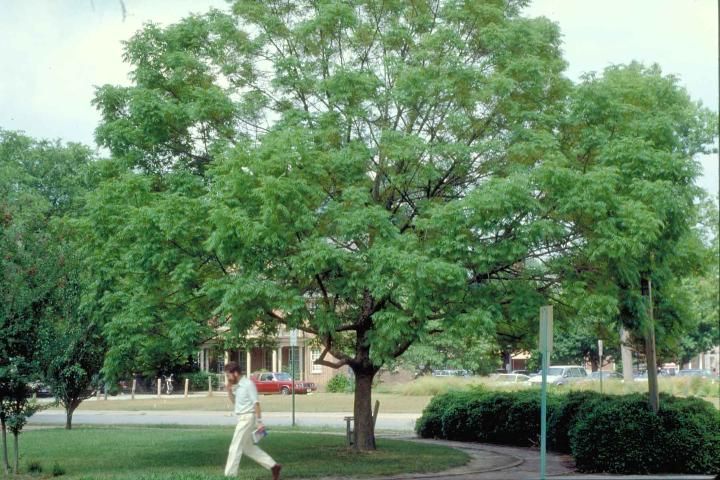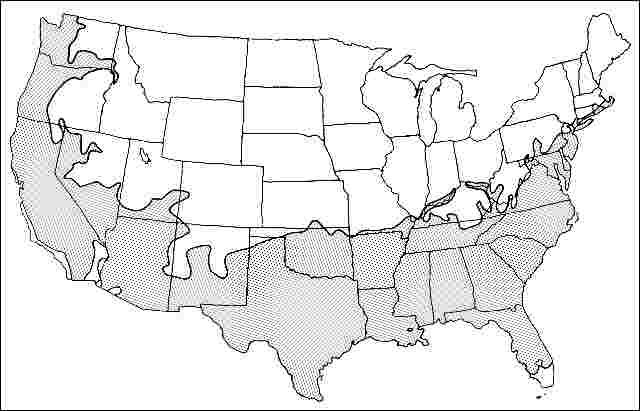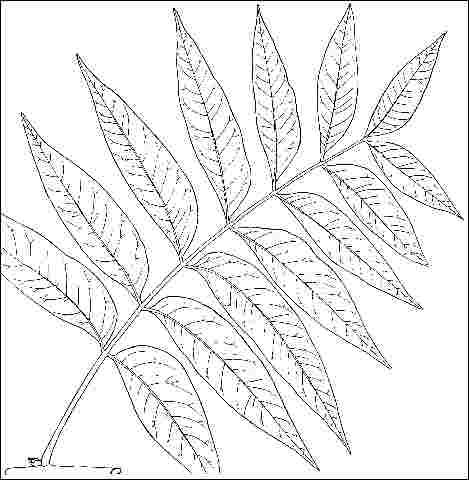Introduction
Finely divided, lustrous, dark green foliage, bright red fruit (on female trees) ripening to dark blue, peeling, attractive bark, and wonderful fall colors combine to make Chinese Pistache an outstanding specimen, shade, or street tree. Capable of reaching 60 feet in height with a 25 to 35-foot spread, Chinese Pistache is usually seen at 25 to 35 feet in height with an oval, rounded canopy and light, open branching creating light shade. Branches form a vase-shape which is particularly evident during the winter. Lower branches often droop to the ground with time, forming a wonderfully spreading crown. Older, more mature trees become more dense and uniformly-shaped. Young trees are asymmetrical and a bit awkward-looking unless properly pruned in the nursery. For this reason, it has not been widely planted but should be due its adaptability to urban soils.

Credit: Ed Gilman
General Information
Scientific name: Pistacia chinensis
Pronunciation: piss-TAY-shee-uh chih-NEN-sis
Common name(s): Chinese Pistache
Family: Anacardiaceae
USDA hardiness zones: 6B through 9B (Fig. 2)
Origin: not native to North America
Invasive potential: little invasive potential
Uses: reclamation; deck or patio; shade; specimen; street without sidewalk; parking lot island < 100 sq ft; parking lot island 100-200 sq ft; parking lot island > 200 sq ft; sidewalk cutout (tree pit); tree lawn 4-6 feet wide; tree lawn > 6 ft wide; urban tolerant; highway median
Availability: somewhat available, may have to go out of the region to find the tree

Description
Height: 25 to 35 feet
Spread: 25 to 35 feet
Crown uniformity: symmetrical
Crown shape: oval, round, vase, spreading
Crown density: moderate
Growth rate: moderate
Texture: medium
Foliage
Leaf arrangement: alternate (Fig. 3)
Leaf type: even-pinnately compound
Leaf margin: entire
Leaf shape: lanceolate
Leaf venation: pinnate
Leaf type and persistence: deciduous
Leaf blade length: 2 to 4 inches
Leaf color: green
Fall color: red, orange
Fall characteristic: showy

Flower
Flower color: red
Flower characteristics: showy
Fruit
Fruit shape: oval, round
Fruit length: less than .5 inch
Fruit covering: fleshy
Fruit color: red, green, blue
Fruit characteristics: does not attract wildlife; showy; fruit/leaves a litter problem
Trunk and Branches
Trunk/bark/branches: branches droop; showy; typically one trunk; thorns
Pruning requirement: needed for strong structure
Breakage: resistant
Current year twig color: brown
Current year twig thickness: thick
Wood specific gravity: unknown
Culture
Light requirement: full sun, partial sun or partial shade
Soil tolerances: clay; sand; loam; alkaline; acidic; well-drained
Drought tolerance: high
Aerosol salt tolerance: none
Other
Roots: not a problem
Winter interest: yes
Outstanding tree: yes
Ozone sensitivity: unknown
Verticillium wilt susceptibility: susceptible
Pest resistance: free of serious pests and diseases
Use and Management
The wood is extremely durable and the outer, grey-brown, fissured bark flakes off to reveal the attractive, salmon red or orange inner bark. The colorful red-orange to pink fruits appear in large panicles and are quite showy in late summer and autumn in USDA hardiness zones 8 and 9 but do not cause a significant litter problem. Fall color is reliably bright red or orange in USDA hardiness zone 8 and colder areas and makes one of the most brilliant shows of any tree, but fall color is less reliable in warmer climates. This is one of the last trees to color in the fall, extending the fall color show in many parts of the south into November.
The tree needs special pruning and training in the early years to create branches in desirable places along the trunk. It often grows with few branches, or with branches clustered at one point on the trunk, if it was topped in the nursery. To train an unbranched young sapling, prune the top to force development of several branches. Pick one to be the trunk, another to be a branch and remove the rest. Allow the tree to grow taller and again top the unbranched trunk 18 to 24 inches above the first pruning cut to force branch development there. Build the tree in this fashion until a desirable structure with well spaced branches is achieved.
This is certainly an underutilized urban tree. It has merit for wider use in urban street tree plantings and in other adverse sites due to its drought tolerance, adaptability, moderate size, and wonderful form and fall color. It is hard to go wrong with Chinese Pistache in all areas within its range. Its range is occasionally extended to hardiness zone 6a.
Chinese Pistache grows quickly in full sun to partial shade on moderately fertile, well-drained soils and will withstand heat and drought extremely well. The crown is quite round and symmetrical on older specimens when grown in full sun but becomes misshapen in too much shade - best for full sun areas. Grows in clay, loam, or sand in a wide range of soil pH.
Chinese Pistache is used as the understock on which the commercial pistachio nut ( Pistacia vera ) is grafted. The cultivar `Keith Davey' has outstanding autumn color.
Propagation is by seed.
Pests
No pests are of major concern. This tree is about as pest-free as any tree.
Diseases
Verticillium wilts and oak root fungus occasionally affect Chinese Pistache.